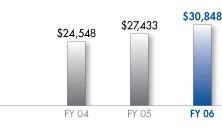| |

Our primary goal for fiscal 2006 was to accelerate our transformation to customer
centricity. In this letter, I’d like to give you an update on this work, which contributed to
the 22-percent increase in earnings from continuing operations we garnered for fiscal
2006. Since the past is often prologue to the future, I’d like to describe how customer
centricity is influencing not only our goals for fiscal 2007, but also our long-term plans.
At Best Buy, customer centricity means treating each customer as a unique individual,
meeting their needs with end-to-end solutions, and engaging and energizing our employees to serve them. It is our primary strategy for providing a differentiated
experience for customers. Mass merchants, direct sellers, other specialty retailers and
online retailers are increasingly interested in our product categories because of rising
demand. If we can understand our customers better than our competitors do, and if we can inspire our employees to have richer interactions with customers, then we can
more effectively compete. We believe that Best Buy excels based on its fun, interactive
store experience; broad product assortments; name brands; knowledgeable employees; and ability to offer services.
Customer centricity has been, and will continue to be, a growth driver for us. By
tuning in customers and employees more closely, we are being rewarded with new
ideas every day—ideas that in the past would not have made their way to headquarters and have been implemented at other stores. Through the employees who work
closest to our customers, we have discovered several material growth opportunities
for the company. The opportunities with the highest potential include small-business
customers, new services offerings and international growth, which we estimate are
at least $230 billion markets in aggregate.
Frankly, it is a challenging goal to become customer-centric, as we have defined
it. Moreover, given that consumers’ tastes are constantly changing (as are product
cycles), our goal has become a moving target, forcing continuous improvement.
To me, that is very exciting!
Accelerating Customer Centricity
We began our customer centricity work three years ago, starting with a few lab stores
that created an energized new culture. Before long, we saw positive indicators from
these lab stores: higher comparable store sales gains and a richer mix of products.
While the expenses associated with this more labor-intensive model also were higher,
the lab stores demonstrated potential to expand their overall profit contribution. We
observed improvements in customer loyalty, employee retention and market share.
Over time, we also noticed new growth ideas coming from our employees, such as
possible real estate locations across North America, a faster method for customizing
personal computers, new services we can offer and ways to reduce returns/exchanges
of flat-panel TVs. Given these positive indicators, we made the decision to accelerate
this work, and we called fiscal 2006 our tipping point.
|
|
Key Wins
Revenue
A 4.9% comparable store sales gain,103
net new store openings and a continued shift
toward higher-ticket items drove fiscal 2006
revenue growth.
 (U.S. dollars in millions)
(U.S. dollars in millions)
|
|
